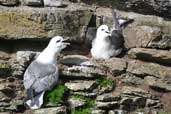
Scotland
The Northern Fulmar is closely related to the Albatrosses in a group of birds sometimes referred to as "tube-noses". This name is derived from the tube that lies along the top ridge of the bill which contains the nostril and gives this group of birds a remarkably keen sense of smell used for finding food out at sea.

They are found in the Northern oceans and set up large nesting colonies on cliffs in about May. They only lay one egg and by July, the chicks are looking very like their parents.
In the UK about 100 years ago they were only found nesting on St. Kilda in the Outer Hebrides. Since then they have set up more than 500 colonies around the British Isles. A possible reason for this population explosion might have been the change in fishing techniques towards the end of the 19th century when, with the advent of power-driven trawlers and steam winches, etc., catches became bigger and the offal from the catch became more abundant.





| Previous Page | Back to Index | Next Page |